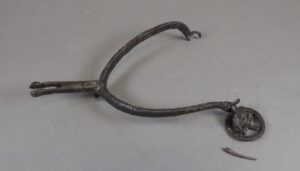Iron Spur
Object
The object is a 14th / early 15th century iron rowel spur with surviving circular iron buckle fastener. It was uncovered near Elvet Bridge by Gary Bankhead and is now part of the river wear assemblage.
The Site

Between 2008 and 2019, archaeological investigations of a submerged river bed, positioned just downstream of the twelfth century Elvet Bridge in Durham City, County Durham, have revealed an important multi-period underwater archaeological site. This site has eventually yielded a significant collection of typically small metal finds, the total number of which now exceeds 13,000 objects.

The find site, positioned just downstream of the twelfth century Elvet Bridge in Durham City, lies mid-way between two areas of late-medieval urban development: the Borough of New Elvet and the Bishop’s Borough.
Condition
- Signs of dirt on the surface
- Evidence of orange corrosion on much of the surface
- A small pin was attached to the buckle.
Conservation

Goal: Remove the dirt and orange corrosion products to reveal the magnetite layer in order to reveal an accurate physical representation of the spur and to discourage further corrosion.
Investigation: To understand the extent of the corrosion and construction, the spur was X-radiographed at 110 kV for 0.8 minutes. This indicated that the spur was very well preserved and that the existing components around the rowel box were corrosion and not metallic iron

Cleaning: To remove the corrosion from the surface, the spur underwent air abrasion treatment. Aluminium oxide was used with compressed air in order to remove the top layer of corrosion and reveal the magnetite layer. During this process it was discovered that the spur was tin plated – this was confirmed by XRF analysis.

During air abrasion it became clear that the small pin attached by corrosion to the buckle was not an original component and following approval from the owner this was removed and stored alongside the spur.
Coating: The spur was coated to prevent risk of further corrosion; this effectively creates a barrier between the iron and agents of corrosion (oxygen and moisture). Two coats of 6% solution of Paraloid B-72 in acetone was brushed onto the surface – Paraloid B-72 effectively coats the metal; it won’t degrade or encourage the degradation of the spur and is reversible.
